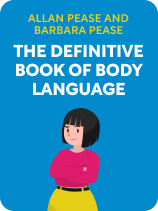

This article is an excerpt from the Shortform book guide to "The Definitive Book of Body Language" by Allan Pease and Barbara Pease. Shortform has the world's best summaries and analyses of books you should be reading.
Like this article? Sign up for a free trial here.
Want to learn how to have more confident body language? What kind of body language expresses confidence?
In the quest for confidence, understanding the secrets of body language can be your greatest ally. Renowned communication experts Allan and Barbara Pease reveal the key to unlocking confident body language in their book, The Definitive Book of Body Language.
Read on to learn the basics of expressing confident body language, according to Allan and Barbara Pease.
How to Have More Confident Body Language
In The Definitive Book of Body Language, communication experts and best-selling authors Allan and Barbara Pease argue that body language plays a key role in shaping interactions between people. The authors explain that during verbal interactions, people pay more attention to the facial expressions, gestures, and postures they see than the words they hear. Therefore, if you want to know how to have more confident body language, then knowing how to interpret body language—and show the right body language—can help you appear more confident to others.
Below, we’ll explain the body language cues you should adopt if you want to appear more confident to others, according to the advice in The Definitive Book of Body Language.
Body Language Cues
Body language cues tend to fall into one of five categories, each displaying a person’s level of friendliness, confidence, dominance, interest and agreement, and honesty.
(Shortform note: The authors organize body language cues according to specific body parts. We’ve chosen to organize them into these five categories to demonstrate how they relate to specific emotions or intentions.)
Let’s explore the body language of confidence in detail.
What Body Language Shows Confidence?
Understanding the body language cues that express confidence can serve a variety of purposes. For instance, you can use this information during professional situations to appear more self-assured and competent. During social interactions, you can use it to figure out how comfortable and at ease others feel around you.
According to Allan and Barbara Pease, confident people tend to stand or sit up straight with their feet apart and their heads held high and make regular eye contact. On the other hand, unconfident people tend to slouch, guard themselves (for example, by folding their arms, crossing their legs, or holding something in front of their bodies), fidget (they might bite their nails, tap their feet, or play with jewelry), and avoid eye contact.
(Shortform note: An advantage of adopting confident body language is that it can help advance your career. Research suggests that there’s a strong correlation between appearing confident and being perceived as competent, irrespective of your actual work performance. This is due to confirmation bias: When you project confidence, people tend to assume that you’re confident and interpret everything they observe about you to align with this assumption, often disregarding your shortcomings. In contrast, when you project insecurities, people may question your abilities and interpret minor mistakes as “evidence” of your incompetence, making it difficult to earn respect and advance your career.)
Express Honesty to Display Confidence
Understanding the body language cues that express honesty can help you build strong relationships and protect you from being taken advantage of. For instance, you can use this information to build trust with others or to assess whether others are lying to you about their intentions or actions.
According to Allan and Barbara Pease, when people are honest about their intentions, they also tend to display confident body language. For instance, they hold a relaxed posture, keep their palms face up while talking, and maintain eye contact. On the other hand, when people are dishonest about their intentions, they tend to make gestures that cover their mouths, eyes, or ears; blink their eyes faster than normal; and avoid eye contact.
(Shortform note: The fact that many police departments and federal agencies use body language analysis during interrogations implies that it’s a reliable method for detecting deception. However, many researchers warn that the interpretation of body language cues can be highly subjective, leading to false accusations or wrongful convictions. They explain that there’s no scientific evidence supporting the idea that a person’s body language can accurately determine if they’re telling the truth, and there’s no consensus on what specific nonverbal cues indicate deception. Therefore, they suggest that police interrogations should rely more on objective evidence, such as eyewitness testimonies and forensic evidence.)
What About Dominance?
Understanding the body language cues that express dominance can be helpful in various contexts. For instance, you can use this information on dominant body language to make yourself appear more authoritative or confident when giving a speech or to navigate the power dynamics in social and professional groups.
Allan and Barbara Pease suggest that dominant people tend to hold an expansive posture (for example, standing with their legs spread and hands on hips, or sitting upright with elbows pointed out), lower their eyebrows, maintain eye contact on the area between the other person’s eyes, place their palms on top and face down when shaking hands, and keep their palms face down while they talk.
On the other hand, submissive people tend to hold a reserved posture (for example, sitting with their shoulders hunched, their head tilted, and their elbows tucked inside the chair), raise their eyebrows, break eye contact first, keep their palms beneath and face up when shaking hands, and keep their palms face up when they talk.
| Personality Types and Power Dynamics Thomas Erikson (Surrounded by Idiots) expands on what the authors say about dominant body language by explaining that certain types of personalities are more likely to display dominant or submissive behaviors. He says people fall into one of four personality types. Each of these types has different motivations that drive their behaviors, determining how dominant or submissive they appear: Red personality: Driven by the desire to dominate or lead others, these people often display direct and aggressive body language, such as shaking hands firmly or using sharp hand gestures. Yellow personality: Driven by the desire to inspire or influence others, these people often display intimate body language, such as sitting close to or touching people frequently. Green personality: Driven by the desire for routine and security, these people often display relaxed body language, such as maintaining friendly eye contact and smiles. Blue personality: Driven by the desire to comply, or to do things as they’re meant to be done, these people often display reserved body language, such as sitting perfectly still or crossing their arms or legs. |

———End of Preview———
Like what you just read? Read the rest of the world's best book summary and analysis of Allan Pease and Barbara Pease's "The Definitive Book of Body Language" at Shortform.
Here's what you'll find in our full The Definitive Book of Body Language summary:
- The role body language plays in shaping your daily interactions
- Why other people respond to body language the way they do
- How to adapt your body language to garner positive responses from others






